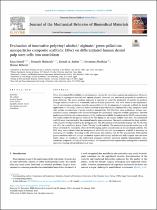| dc.contributor.author | Ismail, Enas | |
| dc.contributor.author | Mabrouk, Mostafa | |
| dc.contributor.author | Salem, Zeinab A. | |
| dc.contributor.author | AbuBakr, Nermeen | |
| dc.contributor.author | Beherei, Hanan | |
| dc.date.accessioned | 2023-04-12T08:20:11Z | |
| dc.date.available | 2023-04-12T08:20:11Z | |
| dc.date.issued | 2023 | |
| dc.identifier.citation | Ismail, E., Mabrouk, M., Salem, Z. A., AbuBakr, N., & Beherei, H. (2023, April). Evaluation of innovative polyvinyl alcohol/ alginate/ green palladium nanoparticles composite scaffolds: Effect on differentiated human dental pulp stem cells into osteoblasts. Journal of the Mechanical Behavior of Biomedical Materials, 140, 105700. https://doi.org/10.1016/j.jmbbm.2023.105700 | en_US |
| dc.identifier.uri | https://doi.org/10.1016/j.jmbbm.2023.105700 | |
| dc.identifier.uri | http://hdl.handle.net/10566/8759 | |
| dc.description.abstract | Three-dimensional (3D) scaffolds are attracting great concern for bone tissue engineering applications. However,
selecting an appropriate material with optimal physical, chemical, and mechanical properties is considered a
great challenge. The green synthesis approach is essential to avoid the production of harmful by-products
through textured construction, sustainable, and eco-friendly procedures. This work aimed at the implementa tion of natural green synthesized metallic nanoparticles for the development of composite scaffolds for dental
applications. In this study, innovative hybrid scaffolds of polyvinyl alcohol/alginate (PVA/Alg) composite loaded
with various concentrations of green palladium nanoparticles (Pd NPs) have been synthesized. Various char acteristic analysis techniques were used to investigate the synthesized composite scaffold’s properties. The SEM
analysis revealed impressive microstructure of the synthesized scaffolds dependent on the Pd NPs concentration.
The results confirmed the positive effect of Pd NPs doping on the sample stability over time. The synthesized
scaffolds were characterized by the oriented lamellar porous structure. The results confirmed the shape stability,
without pores breakdown during the drying process. The XRD analysis confirmed that doping with Pd NPs does
not affect the crystallinity degree of the PVA/Alg hybrid scaffolds. The mechanical properties results (up to 50
MPa) confirmed the remarkable effect of Pd NPs doping and its concentration on the developed scaffolds. The
MTT assay results showed that the incorporation of Pd NPs into the nanocomposite scaffolds is necessary for
increasing cell viability. According to the SEM results, the scaffolds with Pd NPs provided the differentiated
grown osteoblast cells with enough mechanical support and stability and the cells had a regular form and were
highly dense. In conclusion, the synthesized composite scaffolds expressed suitable biodegradable, osteo conductive properties, and the ability to construct 3D structures for bone regeneration, making them a potential
option for treating critical deficiencies of bone. | en_US |
| dc.subject | 3D scaffold | en_US |
| dc.subject | Polymer hybrids | en_US |
| dc.subject | Green Pd NPs | en_US |
| dc.subject | Aspalathus linearis extract | en_US |
| dc.subject | Dental pulp stem cells Osteoblasts | en_US |
| dc.title | Evaluation of innovative polyvinyl alcohol/ alginate/ green palladium nanoparticles composite scaffolds: Effect on differentiated human dental pulp stem cells into osteoblasts | en_US |
| dc.type | Article | en_US |

